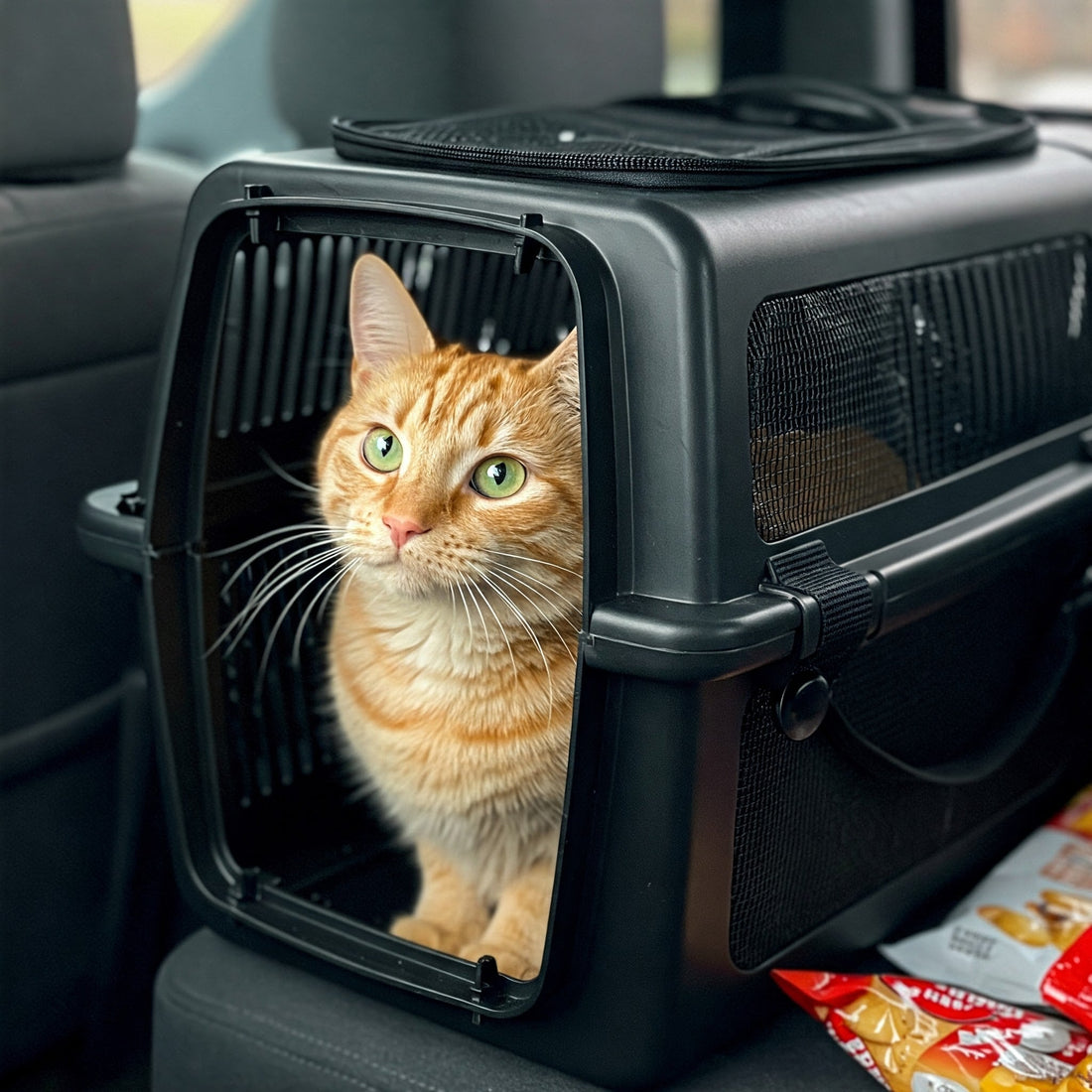
Choosing the Right Carrier for Your Cat's Travel Needs
Share
The relationship between a cat and its carrier is often fraught with tension—a necessary evil that transforms from a cozy napping spot into a dreaded prison the moment it’s associated with vet visits or travel. Yet the right carrier can mean the difference between a stress-free journey and a traumatic ordeal for both feline and human. Selecting this essential piece of equipment requires more than grabbing the first plastic kennel at the pet store; it demands an understanding of feline psychology, physical comfort, and the specific demands of different travel scenarios. A well-chosen carrier becomes not just a transport device but a mobile safe space, a familiar haven in unfamiliar environments, and sometimes even a temporary home during extended trips.

How Do You Choose the Perfect Cat Carrier? (And Why It Matters More Than You Think)
Material choice forms the first critical decision point. Hard-sided plastic carriers, the most common variety found in veterinary offices, offer durability and protection—essential for cats who might need containment during chaotic travel situations. Their solid construction prevents collapses in tight spaces and provides insulation against temperature extremes, while the ventilation holes maintain airflow without exposing the cat to drafts. Yet these utilitarian boxes often fail to account for feline stress; the opaque walls that provide privacy also limit visibility, potentially increasing anxiety as cats lose their situational awareness. Soft-sided carriers, by contrast, offer a compromise between structure and comfort. Their flexible walls allow the carrier to conform to a cat’s body during moments of stress, creating a swaddling effect that can be calming. Mesh panels provide visibility and superior airflow, though at the cost of reduced privacy and protection. For car travel, where space allows, some owners opt for carrier-configured pet car seats that combine safety harnesses with a semi-open design, permitting visual contact while preventing dangerous roaming.
Size considerations extend far beyond ensuring the cat can physically fit inside. A carrier should be large enough for the cat to stand, turn around, and lie down comfortably—but not so spacious that they’re tossed about during movement. This balance becomes particularly crucial for air travel, where under-seat dimensions impose strict limits. The traditional advice of “bigger is better” backfires when excessive space allows terrified cats to slide uncontrollably during turbulence or vehicle maneuvers. For long trips or multi-cat households, modular carriers with removable dividers offer flexibility, allowing configuration changes as needs evolve. Kittens require special consideration—small enough to need confined spaces for security, yet growing rapidly enough to make adjustable carriers a wise investment. The carrier’s weight capacity matters equally for human comfort; a bulky design loaded with a fifteen-pound cat becomes a logistical challenge during airport sprints or subway transfers.
Entry points transform a simple box into an accessibility puzzle. Top-loading carriers provide the gold standard for stress-free insertion of reluctant felines, allowing placement rather than forced entry through a narrow door. This design proves invaluable for veterinary visits where an anxious cat must be transferred to an exam table, or for home loading when confronting a cat who’s learned to associate carriers with unpleasant outcomes. Front-loading models with dual zippers or latches facilitate easy access but may require more cooperation from the passenger. Some innovative designs incorporate multiple entry options, recognizing that different situations demand different approaches. The door mechanism itself warrants scrutiny—plastic latches should be robust enough to withstand determined escape attempts, while zippers require protective flaps to prevent clever paws from discovering exit strategies mid-journey.
Ventilation represents an often-overlooked lifeline. The minimum requirement of a few small holes fails to account for the reality of stressed panting or temperature fluctuations during transport. Optimal airflow designs incorporate mesh panels covering at least two sides, with openings small enough to contain paws but large enough to prevent claustrophobia. Elevated mesh bases improve air circulation underneath—a critical feature during summer travel or in overheated vehicle compartments. For airline-compliant carriers, the ventilation specifications become non-negotiable; each airline publishes precise requirements about hole size and distribution that can mean the difference between acceptance and rejection at check-in.

Comfort features elevate a functional container to a mobile sanctuary. Removable, machine-washable pads address the inevitable accidents during stressful trips, while moisture-wicking fabrics help regulate temperature. Pheromone-impregnated liners can provide chemical calm for anxiety-prone travelers. Some high-end models incorporate noise-reducing materials to dampen the jarring sounds of travel, while others feature privacy flaps that can be rolled up or down depending on the cat’s preference for visibility versus seclusion. For older cats or those with mobility issues, low-entry thresholds reduce the strain of getting in and out, while orthopedic padding supports arthritic joints during prolonged confinement.
Safety certifications separate marketing claims from genuine protection. For car travel, carriers should ideally meet crash-test standards—an unsettling consideration but necessary for those who frequently transport cats by vehicle. Airline-approved designs must comply with International Air Transport Association (IATA) specifications if used for cargo hold travel, though cabin requirements vary by carrier. Reflective strips or bright colors aid visibility during nighttime emergencies or crowded transit situations. The presence of secure anchor points allows seatbelt threading in cars or leash attachment in unpredictable environments, providing redundancy against accidental openings.

The psychological dimension of carrier training cannot be overstated. The finest design fails if the cat only encounters it during moments of stress. Progressive acclimation—leaving the carrier out with cozy bedding, feeding meals inside, and incorporating play sessions around it—transforms the object from a threat to a neutral or even positive space. Synthetic pheromone sprays applied periodically help reinforce calm associations. For particularly resistant cases, carrier alternatives like harness training (for car travel) or clicker-assisted conditioning may be necessary, though these require extensive advance preparation.
Specialized scenarios demand tailored solutions. Frequent flyers benefit from carriers with expansion features—collapsible sides that provide extra space during layovers in pet relief areas. Urban dwellers navigating public transit might prioritize backpack-style carriers that free up hands while distributing weight ergonomically. Show cats or therapy animals requiring constant travel often graduate to customized rolling carriers with integrated litter areas and feeding stations. For emergency preparedness, carriers with quick-grab handles and pre-stashed supplies (collapsible bowls, emergency contact info) become literal lifesavers during evacuations.

The cleaning and maintenance routine impacts both hygiene and longevity. Carriers accumulate fur, dander, and the occasional stress-induced accident between uses. Hard-sided models permit thorough disinfecting but may retain odors in plastic pores over time. Soft carriers often feature removable, washable liners but require careful drying to prevent mildew in hidden crevices. All carriers benefit from periodic inspection of stress points—zipper teeth, latch mechanisms, and weight-bearing seams—that degrade with use. Having a backup carrier ensures availability during cleaning or unexpected situations while maintaining the primary carrier’s familiar scent profile.
Ultimately, the right carrier reflects an understanding of the individual cat’s personality and needs. The skittish rescue cat might require a fully enclosed, dark den-like space, while the confident explorer may prefer maximum visibility. Older cats need ease of access and joint support, while energetic kittens demand escape-proof security. By matching design features to feline temperament and anticipated travel demands, the carrier becomes not just a transport tool but an extension of the cat’s territory—a portable piece of home that makes the wider world less intimidating. In this careful selection lies the difference between a cat who arrives at destinations wide-eyed with fear and one who emerges calm, curious, and ready to explore.
